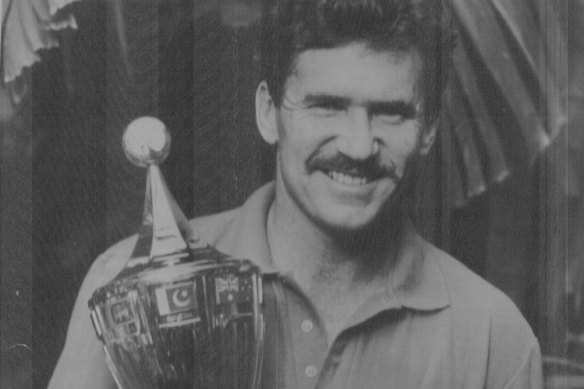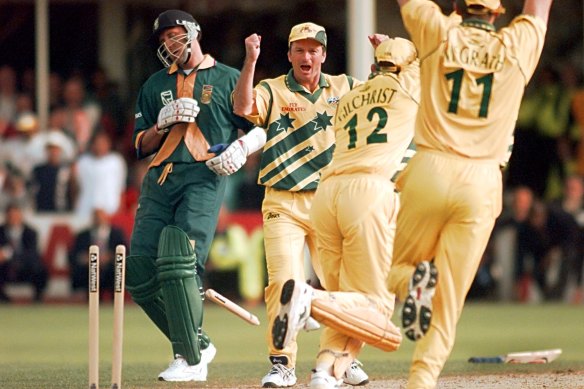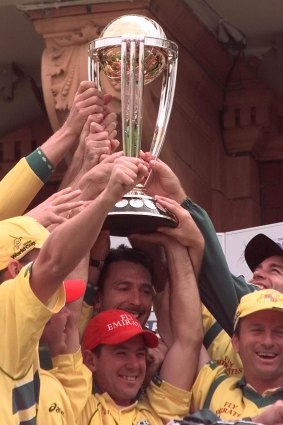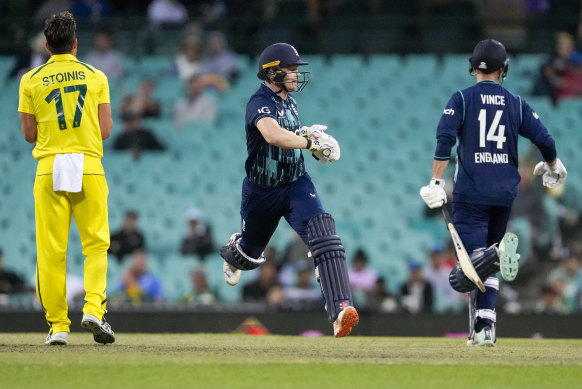‘They’ve just got to grow up’: Australia’s mission to save one-day cricket
Save articles for later
Add articles to your saved list and come back to them any time.
Mike Baird can remember, as a university student, sitting glued to the grainy TV pictures of Australia’s 1987 World Cup victory over England. Specifically, Baird recalls Mike Gatting’s fluffed reverse sweep that turned the final Allan Border’s way.
A decade younger than the Cricket Australia chair, chief executive Nick Hockley had just finished his university exams when he raced to Edgbaston in time to watch Australia squeeze past South Africa in an unforgettable 1999 World Cup semi-final.
Victorious Australian captain Allan Border with the trophy after winning the Cricket World Cup in 1987.Credit: Reuters
Between them, the game’s Australian chiefs share a committed belief that these moments, and their creation of indelible memories, are reason enough for ODI cricket to continue to exist well beyond the current edition of the tournament in India. But for cricket to replicate them, more games have to matter.
The World Cup final in Ahmedabad, the most meaningful 50-over match of the last four years, will be played 12 months to the day after what might have been the most meaningless, except that there have been so many like it.
That was an Australia-England encounter at the SCG, one of three jammed into the program immediately after last year’s Twenty20 World Cup in Australia. England were the newly crowned champions in that format, but Australia won all three of these ODIs. If you’ve forgotten, you’re forgiven; they attracted an aggregate crowd of just more than 40,000.
Those games stuck in the craw of James Sutherland, the former CA chief executive who was just starting out on two decades working in the game when Damien Fleming underarmed the ball to Adam Gilchrist and ran out a forlorn Allan Donald in Birmingham. For years, he and others pushed for an ODI league that served as a World Cup qualifier, with eventual success.
Captain Steve Waugh celebrates as South Africa’s Allan Donald is run out in the classic 1999 semi-final.Credit: AP
But after one cycle, it was scrapped, essentially because some of cricket’s member countries preferred to choose who to play and for how many games, rather than being dictated to by the qualifying league.
“I think that’s basically irresponsible and loses the point,” Sutherland told this masthead. “It might be that they’re gravitating towards T20 cricket, but I do think there’s still a responsibility towards this form of the game and not letting it die.
“If there’s nothing in between, there’s a risk that it becomes irrelevant. I’ve heard people contemplating that this could be the last one-day World Cup. That would be a tragedy. It’s a great event. So somehow, some additional context around a league is a good thing.
“That could entail some sort of promotion and relegation system. I know some countries are completely averse to that. Sometimes, they’ve just got to grow up for the better.”
The World Cup is a reliably natural high and this one, despite the Byzantine politics, is warming up agreeably. One of its features has been the bold performances of minnows Afghanistan and the Netherlands, strengthening the hand of the game’s evangelists. The 10-team one-league formulation is working.
But between World Cups, 50-over cricket has neither rhyme nor reason, and less presence than ever. Here’s one way to chart its decline from what was once the premier alternative form of the game. In a 17-year career, Allan Border played 374 ODIs. In his 16 years, Steve Waugh played 325. After 14 years, David Warner has played 152.
Here’s another way. Even if Australia win this World Cup, they are scheduled to play only three one-dayers between now and next September, in a short series next February against the West Indies – a non-qualifier for this World Cup, don’t forget.
As matters stand, the future tours program lists just more than 30 one-dayers for Australia in the four years before the next World Cup. At the current rate, they will have more children between them than games of 50-over cricket in that span.
It’s the same for everyone. On the eve of this tournament, prominent commentator and incoming Marylebone Cricket Club president Mark Nicholas suggested 50-over cricket should be played only at World Cups henceforth, the way best-of-five set tennis played only at majors.
But England champion Joe Root this week appealed for authorities to reassert the relevance and importance of one-day cricket.
“It’s got a huge amount of history and it brings a lot to cricket,” Root told UK reporters amid a grim cup campaign for Jos Buttler’s team. “It will always hold a very special part of my heart for what it’s given me throughout my career. I think that’s a question that should be posed to the next generation of players, and to everyone watching the game, really.
“It shouldn’t be down to, ‘Is it bringing the most money for the sport?’ It should be down to what people want to watch, and what’s going to engage the next generation of players. Because in the long term, I think that’s going to be most beneficial for cricket all-round.”
In a series of meetings in November, the ICC will ponder all this. A report in The Cricketer this week suggested that it could lead to junking of the World Cup in its current format. It cited dwindling crowds, television audiences and broadcast revenue.
Disney Star, whose properties include the IPL and some one-day internationals in India, recently announced a loss of $US444 million ($700 million) and is not happy about it. The current event, however disorganised, is still doing big broadcast numbers – repeatedly breaking previous streaming records for matches involving India in particular.
Australia’s Ricky Ponting (centre) with Damien Fleming behind him after the 1999 Cricket World Cup win.Credit: AP
In Australia, each 50-over game is worth about $5 million to Cricket Australia, more if it is against England. If it’s against India, it’s up to as much as $9 million. Only a fraction of that comes through the gate. Anonymous as it was, that England series wedged into the schedule last November was to meet a mutually beneficial contractual obligation to broadcasters.
Australia’s position is that the three formats – Test, one-day and Twenty20 – can co-exist, each with its own identity. That’s debatable. One of those three, the Malcolm-in-the-middle, coexists by barely existing at all, except as a revenue-raiser, staged quarterly.
But CA along with some other national boards holds strongly to the principle of context. That is, that each match and series has meaning beyond themselves. Baird and Hockley, jointly, will push hard for the resumption of the ODI league at November’s meetings.
“Precisely what it looks like is to be worked through, but I do think it’s absolutely a prerequisite for bilateral cricket that we have context and it builds to something bigger,” Hockley told this masthead.
“We’re seeing with the introduction of the world Test championship how that works, we’ve seen with the qualification through to this World Cup with major cricketing nations like West Indies missing out and Netherlands coming through.
“So really creating jeopardy in those bilateral series, and that’s something we’ll be discussing when we’re in India towards the end of the tournament with the ICC.”
Australia and England’s one-day series after the Twenty20 World Cup last year barely raised a blip.Credit: AP
The inclusion of cricket into the Olympics gives context to bilateral Twenty20 internationals, since only the top six in the rankings will compete in Los Angeles in 2028. Ranked fourth right now, Australia will have to play with new urgency.
Some matches and series are organically meaningful because they exist in a context bigger than cricket. The Ashes are one, India-Pakistan matches another. Encounters between Australia and New Zealand can be included because they are a form of sibling rivalry.
Their epic clash in Auckland in the group stage of the 2015 World Cup re-alerted Australian authorities to the possibilities of trans-Tasman cricket. The Chappell-Hadlee trophy, and the trans-Tasman for Tests, were worthwhile after all – four years later, New Zealand were playing at the MCG on Boxing Day. The next instalment of the rivalry is on Saturday in Dharamshala.
So what will happen? Whatever India wants to happen, that’s what.
That might not necessarily sound the death knell for one-day cricket and the World Cup. The first World Cup staged outside England was in India and Pakistan in 1987, setting up the final a young Mike Baird watched so intently.
It was so riotously successful that it set a course for the 50-over game around the world for the next quarter a century, and it was the launch pad for India to become the behemoth it is today.
News, results and expert analysis from the weekend of sport sent every Monday. Sign up for our Sport newsletter.
Most Viewed in Sport
From our partners
Source: Read Full Article



